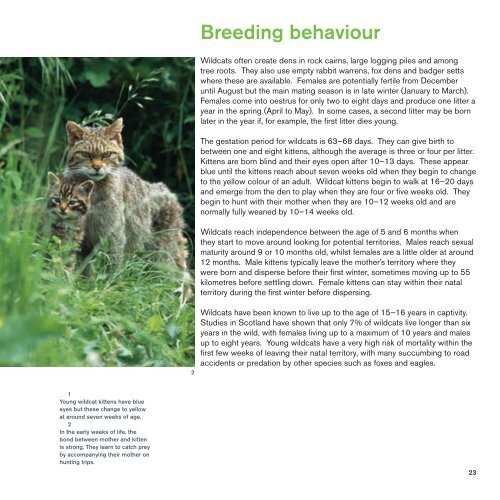Scottish wildcats - Scottish Natural Heritage
Scottish wildcats - Scottish Natural Heritage
Scottish wildcats - Scottish Natural Heritage
You also want an ePaper? Increase the reach of your titles
YUMPU automatically turns print PDFs into web optimized ePapers that Google loves.
1<br />
Young wildcat kittens have blue<br />
eyes but these change to yellow<br />
at around seven weeks of age.<br />
2<br />
In the early weeks of life, the<br />
bond between mother and kitten<br />
is strong. They learn to catch prey<br />
by accompanying their mother on<br />
hunting trips.<br />
2<br />
Breeding behaviour<br />
Wildcats often create dens in rock cairns, large logging piles and among<br />
tree roots. They also use empty rabbit warrens, fox dens and badger setts<br />
where these are available. Females are potentially fertile from December<br />
until August but the main mating season is in late winter (January to March).<br />
Females come into oestrus for only two to eight days and produce one litter a<br />
year in the spring (April to May). In some cases, a second litter may be born<br />
later in the year if, for example, the first litter dies young.<br />
The gestation period for <strong>wildcats</strong> is 63–68 days. They can give birth to<br />
between one and eight kittens, although the average is three or four per litter.<br />
Kittens are born blind and their eyes open after 10–13 days. These appear<br />
blue until the kittens reach about seven weeks old when they begin to change<br />
to the yellow colour of an adult. Wildcat kittens begin to walk at 16–20 days<br />
and emerge from the den to play when they are four or five weeks old. They<br />
begin to hunt with their mother when they are 10–12 weeks old and are<br />
normally fully weaned by 10–14 weeks old.<br />
Wildcats reach independence between the age of 5 and 6 months when<br />
they start to move around looking for potential territories. Males reach sexual<br />
maturity around 9 or 10 months old, whilst females are a little older at around<br />
12 months. Male kittens typically leave the mother’s territory where they<br />
were born and disperse before their first winter, sometimes moving up to 55<br />
kilometres before settling down. Female kittens can stay within their natal<br />
territory during the first winter before dispersing.<br />
Wildcats have been known to live up to the age of 15–16 years in captivity.<br />
Studies in Scotland have shown that only 7% of <strong>wildcats</strong> live longer than six<br />
years in the wild, with females living up to a maximum of 10 years and males<br />
up to eight years. Young <strong>wildcats</strong> have a very high risk of mortality within the<br />
first few weeks of leaving their natal territory, with many succumbing to road<br />
accidents or predation by other species such as foxes and eagles.<br />
23

















